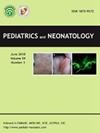血浆 MiR-190 是儿童急性呼吸窘迫综合征的潜在临床生物标志物,它通过靶向 KLF15 在 ARDS 细胞模型中发挥调节作用。
IF 2.3
4区 医学
Q2 PEDIATRICS
引用次数: 0
摘要
背景:本研究旨在探讨急性呼吸窘迫综合征(ARDS)患儿血浆miR-190的临床价值以及miR-190对LPS诱导的ARDS细胞模型的影响:方法:采用实时定量反转录 PCR(RT-qPCR)技术测定血浆 miR-190 水平。建立经 LPS 处理的人肺微血管内皮细胞(HPMECs),然后转染 miR-190 mimic、抑制剂或 miR 阴性对照组。用酶联免疫吸附试验(ELISA)检测炎症因子的水平。通过 CCK-8 检测法和流式细胞术评估了 miR-190 对 HPMEC 增殖和凋亡的影响。通过荧光素酶报告实验检测了 miR-190 对 KLF15 的调控作用:结果:ARDS患儿血浆miR-190表达增加,且与病情严重程度和28天存活率呈正相关。血浆 miR-190 可以区分 ARDS 儿童和健康儿童。抑制 miR-190 可增加 LPS 诱导的 HPMEC 细胞增殖,减少细胞凋亡和炎性细胞因子 IL-6、IL-1β 和 TNF-α。KLF15 是 miR-190 的直接靶标:结论:血浆 miR-190 的增加可能是 ARDS 儿童的临床诊断和预后预测指标。通过靶向 KLF15 增加细胞增殖、抑制细胞凋亡和炎症反应,抑制 miR-190 可改善 LPS 诱导的 ARDS。本文章由计算机程序翻译,如有差异,请以英文原文为准。
Plasma MiR-190 is a potential clinical biomarker for acute respiratory distress syndrome in children and its regulatory role in ARDS cell models by targeting KLF15
Background
The present research aimed to investigate the clinical value of plasma miR-190 in children with acute respiratory distress syndrome (ARDS) and the impact of miR-190 on LPS-induced ARDS cell models.
Methods
The plasma miR-190 levels were measured using real-time quantitative reverse transcription PCR (RT-qPCR). LPS-treated human pulmonary microvascular endothelial cells (HPMECs) were established and then transfected with miR-190 mimic, inhibitor, or miR-negative controls. The levels of inflammatory factors were detected by enzyme-linked immunosorbent assay (ELISA). The effects of miR-190 on HPMEC proliferation and apoptosis were evaluated by CCK-8 assay and flow cytometry. The regulation of KLF15 by miR-190 was detected by luciferase report assay.
Results
The plasma miR-190 expression was increased in ARDS children and it was positively related to the severity and 28 day-survival. Plasma miR-190 could distinguish ARDS children from healthy children. Inhibition of miR-190 increased LPS-induced HPMEC cell proliferation and decreased cell apoptosis and inflammatory cytokines IL-6, IL-1β, and TNF-α. KLF15 was a direct target of miR-190.
Conclusion
Increased plasma miR-190 may be a clinical diagnostic and prognostic predictor for ARDS children. Inhibition of miR-190 may improve LPS-induced ARDS by increasing cell proliferation, inhibiting cell apoptosis and inflammatory response by targeting KLF15.
求助全文
通过发布文献求助,成功后即可免费获取论文全文。
去求助
来源期刊

Pediatrics and Neonatology
PEDIATRICS-
CiteScore
3.10
自引率
0.00%
发文量
170
审稿时长
48 days
期刊介绍:
Pediatrics and Neonatology is the official peer-reviewed publication of the Taiwan Pediatric Association and The Society of Neonatology ROC, and is indexed in EMBASE and SCOPUS. Articles on clinical and laboratory research in pediatrics and related fields are eligible for consideration.
 求助内容:
求助内容: 应助结果提醒方式:
应助结果提醒方式:


